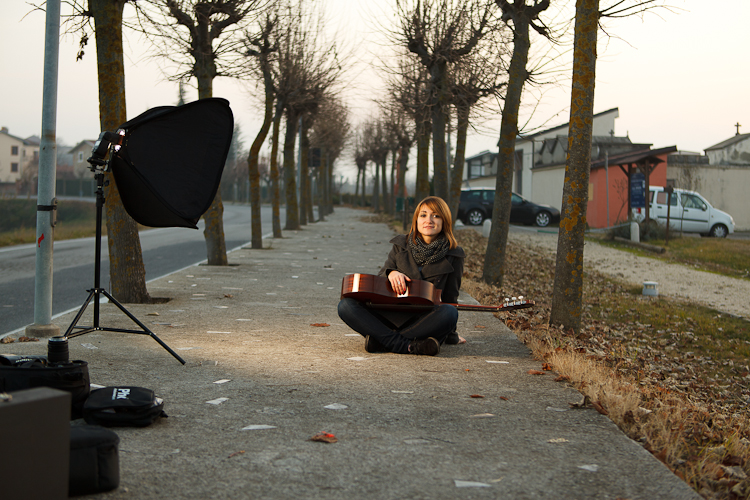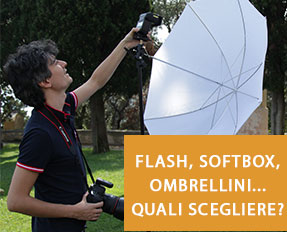[it]Ciao ragazzi!
In questo episodio torna finalmente Paola, che ricorderete per vari set precedenti, il più famoso dei quali è quello con lei vestita anni ’70 🙂 Questo set è stato pensato così: mettiamo che io sono un fotografo e una chitarrista/cantante mi chiede di farle un set per il cd, che foto le farei? Questo sarebbe il mio stile.. che può benissimo non piacere a tutti 🙂
Vi propongo 3 foto del set (che trovate al fondo dell’articolo) e 2 backstage, due dei quali vi fanno vedere com’erano disposti i flash.. e vi parlo invece di come è difficile gestire una lente come il 135mm f\2. Questa lente infatti è talmente luminosa che usarla con i flash non è scontato. Prendete la foto numero 1 del set, e il relativo backstage. Nel momento in cui montavo il tutto avevo già in mente di farla ad f\2, pertanto ho dovuto valutare attentamente gli altri due parametri su cui giocare, ovvero il tempo di esposizione l’ISO.
Ma andiamo per gradi.. innanzitutto sono partito da una foto senza flash. La macchina fotografica per avere esposizione sullo 0 (ovvero foto nè sovraesposta nè sottoesposta) ad ISO 100 mi dava come tempo di esposizione 1/800. Giustamente ad f/2 di luce ne entra parecchia, con conseguenti tempi molto rapidi, che come sapete non vanno molto d’accordo con l’uso dei flash. Infatti, a meno di utilizzare tecniche particolari come l’high sync, i flash fanno il loro dovere solo se stiamo entro un tempo detto tempo di sync. Per la mia 5d markII tale tempo è di 1/200. Pertanto, se voglio utilizzare i flash con i trigger radio devo stare sotto tale tempo. La soluzione più semplice sarebbe stata quella di chiudere due stop, quindi fare la foto ad f\4, in maniera tale che il tempo si fosse allungato a 1/200.
Ma io la foto la volevo ad f\2!!
Pertanto per prima cosa ho pensato che il fondo andava sottoesposto di uno stop (infatti deve essere meno importante del soggetto, e quindi va sottoesposto). Con questa mossa sono passato alla tripletta ISO 100, F\2, 1/400. Non ancora sufficiente.. bisognava limare ancora uno stop, e non avevo voglia di avere lo sfondo sottoesposto di 2 stop. E qua pertanto ho deciso di utilizzare l’estensione degli ISO della 5d markII. Infatti, come è capace di andare molto su di ISO, la 5d ha anche la possibilità di impostare un ISO L (che sta per Low) ed equivale ad utilizzare ISO 50. Così facendo per avere esposizione -1 ho impostato la tripletta ISO 50, F\2, 1/200.. e voilà siamo arrivati al tanto desiderato 1/200, e in più ad f\2 come mi ero prefisso. A questo punto è stato sufficiente valutare la potenza del flash nel softbox che illuminava Paola (per la cronaca mi sembra fosse 1/8 power, 24mm), posizionargli sopra un bel gel 1/2 CTO, e voilà il gioco è fatto.. trovate il risultato della foto 1, che ne dite??
Le altre due foto sono tecnicamente meno difficili, ma spero le apprezziate lo stesso.. con i capelli davanti fa molto più copertina di Rolling Stones (secondo me eh!! hihi)
Alla prossima ragazzi!!
Stefano[/it][en]Hi guys!
In this episode comes back Paola, who you remember for the previous sets, the most famous of which is the one in the 70’s 🙂 This set has been thought in this way: let us assume that I am a photographer and a guitarist/singer asks me to do her a set, which photos I would make? This would be my style.. which could not be loved by all 🙂
I propose to you 3 photos (which you’ll find at the end of the article) and 2 backstages, in two of which you can see the strobist setup.. and I explain to you how it is difficult to use a lens like the 135mm f\2. This lens is so open that use it with the flash is very difficult. Let us take the first photo of the set, and the relative backstage. In the moment in which I was preparing the lights I already had in mind to do the shot at f\2, so I had to evaluate with attention the other two parameters, i.e. the shutter time and the ISO.
But let us analyze from the beginning.. first of all I started with a photo without flash. The camera was set in order to have exposition on 0 (nor underexposed, nor overexposed) on ISO 100, and it gave me shutter time 1/800. At f\2 a lot of light enters in the lens, with consequent very rapid shutter times, which are not very good for the strobist use. In fact, except the use of particular techniques like the high sync, strobes work only if we are with times longer than the sync time. For my 5d markII is 1/200. Therefore, if I want to use radio trigger I have to stay under this time. The simplest solution would have been to close about two stops, so to do the photo at f\4, in order to have the shutter time 1/200.
But I wanted the photo at f\2!!
Therefore first of all I thought that the background should have been underexposed by one stop (in fact it should be less important than the subject, and so it must be underexposed). With this, I passed to the group of parameters ISO 100, f\2, 1/400. Not al all sufficient.. a stop whould have been removed, and I didn’t want to underexpose 2 stops. And here I had to use the ISO extension of the 5d markII. In fact, as it is able to go very high with ISO, the 5d has the possibility to set a ISO L (which stands for Low) and it is equivalent to use 50 ISO. Doing this I had exposition -1 with the three values ISO 50, F\2, 1/200.. and voilà we have arrived to the so dreamed 1/200, and moreover at f\2 as I was thinking in the beginning. At this point it has been sufficient to evaluate the flash power in the softbox for lighting Paola (1/8 power, 24mm), put on it a 1/2 CTO gel, and we get it! You can find the result in photo 1, what do you think about it?
The other two photos are technically less difficult, but I hope you like it anyway.. haveing the hair in front of her is very like Rolling Stones first page (in my opinion!! hihi)
See you soon!!
Stefano[/en]







belle tutte… in primo luogo la prima…l’unica cosa che proprio non mi piace nelle altre due è la chitarra….il colore fa a cazzotti con la bella atmosfera che hai creato !
Bellissime!
Nota tecnica, perché non prendi un paio di filtri ND (la classica tripletta ND 2, 4 e 8)? Così ti arrabatti di meno e togli luce senza diaframmare?
Hai perfettamente ragione 🙂 però un bel filtro costa caro.. Prima o poi li prenderó 😉 grazie per il commento!!
Gusti, secondo me quel colore sta una favola con gli altri che son caldi caldi. Fosse stato più blu no
I filtri sono fondamentali! 🙂
Ottimo set Steo.
Giusto una cosa: dato che impostando a ISO L per arrivare al tempo di 1/200 avevi un solo stop di differenza e che hai 3 flash perchè non hai utilizzato l’high sync mettendo due flash assieme??? In questo modo avresti ottenuto la stessa apertura, la stessa potenza di flash senza sottoesporre necessariamente lo sfondo!!! Comunque bellissime tutte e 3, complimenti vivissimi!!!
ciao Paolo! quello che dici tu è perfettamente giusto.. semplicemente quel giorno non avevo voglia di usare l’high sync e dato che si poteva ancora gestire in manuale ho fatto così.. 🙂 grazie per il commento!
Ciao Stefano piacere di conoscerti!
Volevo farti i complimenti sia per la prima foto (a mio parere bellissima) e per la semplicità e chiarezza con cui spieghi i tuoi lavori!
Complimenti!
grazie mille 🙂
Scusa ma non riesco a capire il passaggio di sottoesporre lo sfondo. Fermo restando iso 100 e f 2, se il tempo passa da 1/800 a 1/400 la scena diventa più luminosa e non più scura, quindi hai sopraesposto e non sottoesposto.
Hai perfettamente ragione.. Nella fretta mi sono sbagliato a scrivere l’articolo.. Chiedo venia 🙂 dopo lo modifico, grazie 🙂
Bellissima la prima foto !!!
Stefano, ma tu per la ritrattistica, come obiettivi fissi, noto che hai solo il 50 ed il 135. Io per il momento ho solo il 50 (e 24-70). Secondo te, considerando che vorrei un obiettivo sia per gli interni che esterni, conviene acquistare per prima più il 135 F2, o l’85 ?
in interni il 135 è decisamente troppo lungo.. quindi ti consiglierei l’85. Io sapevo che l’avrei usato quasi esclusivamente in esterno, quindi ho preso il 135 🙂
Ciao Stefano,
Scusami cerco di approfondire per capire tecnicamente la differenza. Nel caso in cui tu avessi fatto la foto con un ombrello piuttosto che con un softbox cosa sarebbe cambiato?
(Ottimi scatti. Personalmente mi piace la prima. Mi piace la composizione che hai trovato, ma sono tutti scatti di alto livello).
Il softbox è molto più direzionale, mentre l’ombrellino spande luce ovunque.. Se devi illuminare una zona ridotta (ad esempio solo il viso, o viso e torace) usi il softbox, altrimenti l’ombrellino.. Dipende quindi quanto vuoi sia ristretto il tuo raggio d’azione!
Ciao,
una curiosità!, hai usato soft box più flash su fotocamera? o separato?
qual è la differenza in resa tra filtri nd e gel?
ottime lezioni.
grazie,
Il softbox era ovviamente staccato dal corpo macchina. I gel e i filtri ND sono due cose completamente diverse tra loro, i primi li applichi sui flash per colorarli e i secondi sulla macchina fotografica per togliere luminosità.
Tana per Stefano 🙂 nell’articolo si parla ancora di sottoesposizione 😉
Ciao Stefano, complimenti per i tuoi articoli e belle le foto! Piacere di conoscerti! Se proprio devo trovare un piccolo difetto nella prima foto e’ la luce del softbox sull’asfalto in prossimità’ della ragazza! Le altre stupende!
grazie!!
Ciao vorrei chiederti se per abbassare i tempi e stare dentro al tempo di sync si possono usare i filtri ND o un polarizzatore.
ovviamente sì, però mettere a fuoco con gli ND è tutt’altro che facile, infatti io tendo a non usarli mai per quello 😉